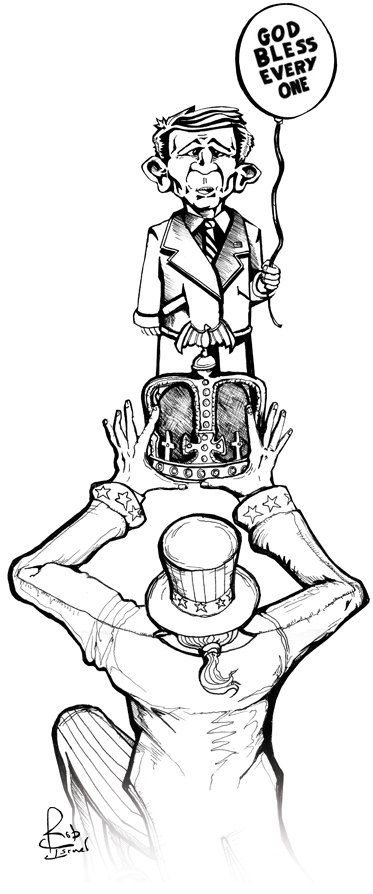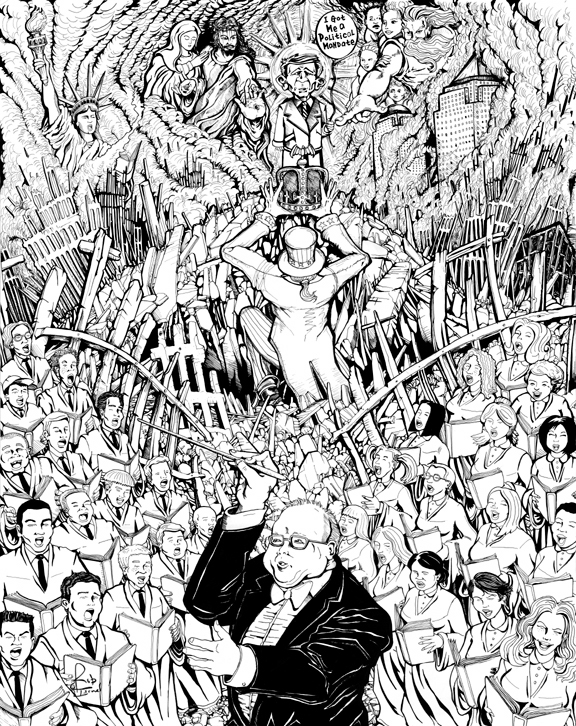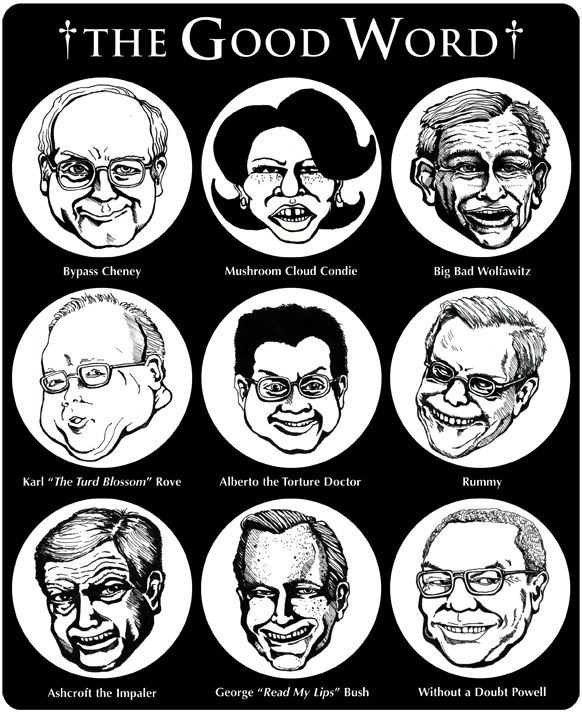 This essay uses performative writing to evoke a particular understanding of the “Bush Doctrine.” The Bush Doctrine constitutes a specific approach to domestic, foreign, economic, and social affairs, and is most characterized by the intended defeat of global terrorism and the defense and expansion of American power. The Administration’s “The National Security Strategy of the United States of America” provides the best overview of Bush’s doctrine. This document—released in September, 2002—uses our post-9/11 war on terror, and the pre-emptive military strategy thereof, to intimidate other countries into submission. Essentially, the Bush Doctrine is a manifesto for overt U.S. expansionism.
This essay uses performative writing to evoke a particular understanding of the “Bush Doctrine.” The Bush Doctrine constitutes a specific approach to domestic, foreign, economic, and social affairs, and is most characterized by the intended defeat of global terrorism and the defense and expansion of American power. The Administration’s “The National Security Strategy of the United States of America” provides the best overview of Bush’s doctrine. This document—released in September, 2002—uses our post-9/11 war on terror, and the pre-emptive military strategy thereof, to intimidate other countries into submission. Essentially, the Bush Doctrine is a manifesto for overt U.S. expansionism.
This essay uses performative writing to substantiate this political perspective. There are three reasons for this methodological choice: (a) the constitution of reality, (b) embodied rhetoricity, and (c) critical communication.
(a) Performance is concerned with the constitution of reality. As we perform, we evoke particular realities that grant unique perspectives, insights, knowledges, and subjectivities. These realities are ephemeral and fleeting; they are here, for now, as long as the performances last, and then are gone, never to be fully recovered or reenacted. But yet, these realities are solid, concrete, lived-through experiences that we point to and say, “Yes, there it is!” Our unique occupations of personal and societal spaces differentiate what we see and how we see it. Together, our performances constitute a decentered, ongoing, never completed world that is part and parcel of competing voices and perspectives.
Performative writing, as one methodological strand of performance scholarship, evocatively expresses and articulates unique realities, bringing about perceptual shifts in both authors and readers. In a sense, all good writing and scholarship does this. But performative writing resists and emphatically argues against the representation of reality; instead, it tries to consciously create reality. Thus, this essay—rather than (re)presenting the “actual”—creates a particular way of seeing and understanding the Bush Doctrine as expansionism.
(b) Performance involves an embodied rhetoricity. Authors and readers are swayed by their gut reactions to the words, images, and evoked perspectives of the following pages. You see, feel, and understand this essay in a visceral manner that both precedes and exceeds conscious cognition. This evocation of a reality is difficult to deny or ignore. The purpose of this essay is laid bare: to provide the conditions for the possibility of experientially understanding the Bush Doctrine as U.S. expansionism. This hopefully leads us to reflection and action. Is our great country, long promulgated as a beacon light of democratic liberalism, really on an imperialist path? If no, then how do readers/authors explain their performative experiences of this essay? If yes, then what course of action can and/or should be taken?
(c) Performance’s non-representational stance allows—actually, beckons—for critical communication. It asks us to give intelligent, substantiated, and well-crafted expression to our own individual views. Rather than describing a world that exists “out there,” we are challenged to articulate the ongoing differentiated worlds that we are discursively embodying. This process logically evolves into critical discussion of the accuracy, practicality, and implications of each perspective. Rather than asking if this essay is true, we need to ask if this essay is believable, legitimate, credible, and pragmatic. Such decentralized and egalitarian scholarship sits in direct contradistinction to the Bush Administration’s authoritarian, black-and-white approach to social and political management. Not only the content, but the form of this essay challenges the prevailing norms and narratives of U.S benevolence and benign Administrative policy-making.
Explaining the “Dum’ Dum” Theme
A driving force of this essay is “Dum’ Dum”—a four-foot floppy-eared caricature who just happens to be the president of the United States of America. Dum’ Dum (you can visit his Myspace page and blog here), the performative star of this essay, was first conceived and developed by Robert Israel, a creative designer and professional illustrator. In many ways, Dum’ Dum is Robert’s performative conception of not only George W. Bush, but of the whole Bush Administration. Dum’ Dum embodies disparate but overlapping power networks and socio-political discourses: neoconservatives, oil tycoons, charismatic evangelicals, war hawks, compassionate conservativism, free-market privatization, corporate globalization, cultures of life, and stuttering, smirking, swaggering cowboy heroism. These overlapping Bourdieu-ian fields help explain Dum’ Dum’s aloof and boyish appearance: He holds a balloon, doesn’t talk, adorns a child’s suit and sandals, communicates with God, glides through the air, and seizes our nation’s imagination. Only something so brilliant could look so dumb. Yes, Dum’ Dum is brilliant—his exterior traits insidiously blind us to an unquenchable thirst for power.
Dum’ Dum is a well-managed PR fabrication that also lives in the real world. Yes, he is among us, a caricature superimposed upon real people, real lives, real families, and real world events. This makes the Dum’ Dum presidency ingenious: it has all the reality, all the power, all the human drama, but none of the accountability, none of the consequences, and none of the conscience. The human agency remains while the existential guilt and dread fade away. This gives an unbridled license to the Dum’ Dum Doctrine of U.S. expansionism. So what if it doesn’t work? Who cares if it backfires? What are you going to do when it inflames world populations? Nothing, and that’s the point. There is no one to blame. Dum’ Dum’s political fabrication will be erased and etched out; it will be flushed down the tubes of repressed collective consciousness forever. Dum’ Dum will be no more, and the world will move onward, albeit, worse off than before.

Illustration, Performance, and Good Word Heads
Visual illustration is obviously a major factor for this performative essay. Performance scholarship has not really considered such a performative form of expression and inscription. This is unfortunate, but understandable. Visual illustration is its own art form, taking years to learn and master. Performance practitioners have plenty to do already without being asked to learn a new medium. But that does not exclude the possibility or success of visual illustration as performance. Such a form can (a) better evoke perceptual shifts, especially since we live in a visual culture; and (b) evoke particular types of experiences that are less prevalent with other performative media (traditional essays, staged performances, online performances, etc).
This essay’s illustrative performance involves more than the Dum’ Dum caricature; it also involves a full-page artistic illustration, smaller side-bar illustrations, and “Good Word” heads. The “heads” need some brief explanation. Every so often you will notice Good Word heads popping up with brief comments. These caricatures, also designed by Robert Israel, are Dum’ Dum cadre; they are engines of the machine fueling and driving the doctrine of expansionism. These antagonistic heads help move the story forward; but also, and more importantly, provide insight to the illogicality and depravity of the Dum’ Dum Doctrine. Dum’ Dum, though a brilliant PR campaign, is actually quite absurd and moronic. The heads help evoke the insanity of this Administration and conjoining doctrine.

With all this being said, we now turn to the main performance: The Dum’ Dum Doctrine.
»next

